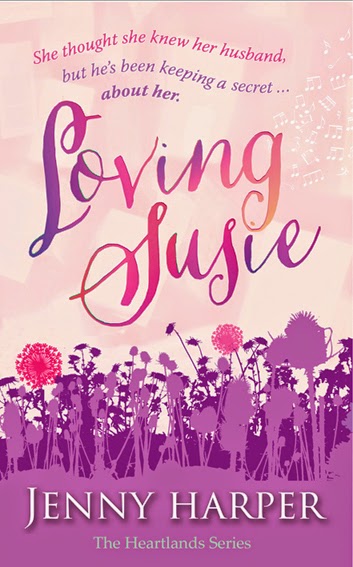Jenny Harper is the author of The Heartlands Series,
published by Accent Press – three titles to date set in and around the
fictional small market town of Hailesbank near Edinburgh. The just-published
Maximum Exposure follows Face the Wind and Fly and Loving Susie.
Maximum Exposure is described on the cover as ‘Page-turning
and thoroughly entertaining. I loved it!’ by Katie Fforde.
from the blurb:
Livelihoods are at risk when a local newspaper begins to
fail, but the future of one member of staff depends more on the choices she
makes than the decisions of others…
Adorable but scatterbrained newspaper photographer Daisy
Irvine becomes the key to the survival of The Hailesbank Herald when her boss
drops dead right in front of her.
I asked Jenny some questions about Maximum Exposure, the series, and her writing process.
Jenny, Daisy is a
delightful character – dizzy and scatterbrained in some ways but with real
emotional depth. She follows your two perhaps more ‘grown-up’ heroines, Kate
Courtenay, wind-farm engineer, in Face the Wind and Fly, and Susie Wallace, a
member of the Scottish Parliament, in Loving Susie. Was Daisy inspired by
anybody you know?
I have no idea where Daisy came from! No, she’s not based on
anyone I know, she just grew in my mind. At one point, I did feel she lacked
depth though. I needed to know more about why she was the way she was – and so
her controlling father walked into the pages of the novel. It would be
interesting to revisit Daisy in a year or two and see how life with Ben might
change her. Now there’s a thought …
We see the story from
Daisy’s viewpoint and from that of her childhood friend Ben. Did you know from
the beginning that you wanted both of them to have a voice?
Yes. I find single viewpoint novels really difficult to
write and admire anyone who can do it. I like to get inside at least two
characters, and I also like to be able to move the action around more than is
possible with a single point of view.
I know that you have
been a journalist and also published non-fiction books. Have you ever worked on
a newspaper?
Only as a freelance. I used to be a regular feature writer
for many Scottish newspapers, particularly The
Scotsman and The Sunday Times Ecosse
(as it was when I wrote for it). But I ran a corporate communications agency
for more than 20 years and we published magazines and newspapers for private
and public sector organisations, from banks and oil companies to organisations
such as Seafood and Historic Scotland.
The setting of the
series is a small community. As far as I’m aware none of the characters so far
cross over from one book to the next. Is that a possibility?
Yes. The next in the series again features new characters,
but the one I’m working on at the moment (Number 5) takes one of the minor
characters and develops her story. And now that I know Hailesbank, Forgie and
Summerfield quite well, I’ll be picking up other characters in major or minor
ways again too.
When will the next
Heartlands title be available?
The People We Love
is due out in ebook format on 26 February and paperback in August, and I
believe it’s my best yet.
And how many do you
envisage being in the series?
Who knows? It depends on many factors – if I continue to
enjoy writing them, if my publisher wants more of them, if readers like them –
and if it doesn’t all become too complicated! I have at least two more novels
roughly planned, but I don’t know whether I’ll develop them or not. But I also
have a hankering to revisit the first novel I ever tried to write, based
loosely on my parents’ experiences during the war, in Scotland and in India. I
didn’t have the technical experience to write back then, but maybe I do now.
Do you like the
writing or the editing best?
It depends which stage of writing I’m at. I love it when
everything starts to come together, and I love enriching what I have written,
making it stronger and deeper. I am appalling in the early stages of a novel, I
go down false avenues, prevaricate, change plot lines and fiddle with
characters. It all takes a while to settle down in my head – but once I
get to a certain point, it’s much easier and I really begin to enjoy it. I love
editing – it was my professional discipline and I think I’m quite good at it.
You had a short story
in the Romantic Novelists’ Association anthology Truly, Madly, Deeply. How do
you like writing short stories compared with novels?
I’m a complete beginner at short stories. I went on a
writing course to the gorgeous Chez Castillon tutored by
Veronica Henry and she decided to spend a morning on short stories. I hadn’t
expected it – but I’ve been so grateful ever since. By the way, I have another
short story coming out on 1 November in an anthology called Let’s Hear It For the Boys It’s all for the
charity Movember, in aid of men’s health, so please do click and buy! A great
read for just 99p and a great cause.
Do you have a website
or a blog?
I also blog at http://novelpointsofview.blogspot.co.uk/
Thank you for
answering my questions – I look forward to seeing more of the Heartlands
community in The People We Love.
Thank you for hosting
me!











